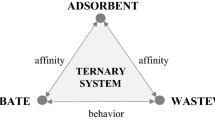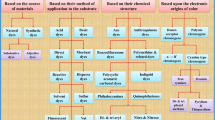Abstract
There are few activated carbons that are capable of adsorbing both ionic and solvent dyes. In this paper, activated carbon was prepared from Chondrus crispus as a marine material by a high-temperature carbonization procedure for the first time. The Chondrus crispus activated carbon (CCAC) can effectively adsorb methylene blue (MB) as a cationic dye, methyl orange (MO) as an anionic dye, oil red O (ORO) as a solvent dye, and other eight dyes. The adsorption capacities for MB and MO in water, and ORO in n-hexane are 132.81, 49.48, and 33.17 mg g−1, respectively. CCAC was characterized by scanning electron microscope (SEM), Fourier transform infrared (FTIR) spectroscopy, Raman spectroscopy, Brunauer-Emmett-Teller (BET) method, and zeta potential analysis. CCAC was proved to have a porous and gully structure with a specific surface area of 60.0687 m2 g−1. The effects of initial dye concentration, dosage, pH, contact time, and temperature on the adsorption were investigated. The adsorption kinetic data proved that the adsorption process accorded with pseudo-second-order model. The adsorption isotherms fit to both the Langmuir and Freundlich models. The broad-spectrum dye adsorption mechanism is attributed to the π-π interaction between CCAC and dye.










Similar content being viewed by others
References
Al-Ghouti, M. A., Khraisheh, M. A. M., Allen, S. J., & Ahmad, M. N. (2003). The removal of dyes from textile wastewater: a study of the physical characteristics and adsorption mechanisms of diatomaceous earth. Journal of Environmental Management, 69, 229–238.
Alvarez, M. S., Moscoso, F., Rodríguez, A., Sanromán, M. A., & Deive, F. J. (2013). Novel physico-biological treatment for the remediation of textile dyes-containing industrial effluents. Bioresource Technology, 146, 689–695.
Bi, Z., Kong, Q., Cao, Y., Sun, G., Su, F., Wei, X., et al. (2019). Biomass-derived porous carbon materials with different dimensions for supercapacitor electrodes: a review. Journal of Materials Chemistry A, 7, 16028–16045.
Ciardelli, G., Corsi, L., & Marcucci, M. (2000). Membrane separation for wastewater reuse in the textile industry. Resources Conservation & Recycling, 31, 189–197.
Dai, L., Wenkun, Z., Li, H., Furong, T., Nengmin, Z., Qin, Z., et al. (2018). Calcium-rich biochar from crab shell: an unexpected super adsorbent for dye removal. Bioresource Technology, 267, 510–516.
Dong, M., Xue, Z., Liu, J., Yan, M., Xia, Y., & Wang, B. (2018). Preparation of carrageenan fibers with extraction of chondrus via wet spinning process. Carbohydrate Polymers, 56, 217–224.
Garg, V. K., Amita, M., Kumar, R., & Gupta, R. (2004). Basic dye (methylene blue) removal from simulated wastewater by adsorption sawdust: a timber using Indian rosewood industry waste. dyes and pigments, 63, 243–250
Guo, Y., Yang, S., Fu, W., Qi, J., Li, R., Wang, Z., et al. (2003). Adsorption of malachite green on micro- and mesoporous rice husk-based active carbon. dyes and pigments, 56, 219–229.
Han, X., Wang, H., & Zhang, L. (2018). Efficient removal of methyl blue using nanoporous carbon from the waste biomass. Water Air & Soil Pollution, 229, 26.
Juang, R. S., Wu, F. C., & Tseng, R. L. (2002). Characterization and use of activated carbons prepared from bagasse for liquid-phase adsorption. Colloids & Surfaces A Physicochemical & Engineering Aspects, 201, 191–199.
Kadirvelu, K., Kavipriya, M., Karthika, C., Radhika, M., Vennilamani, N., & Pattabhi, S. (2003). Utilization of various agricultural wastes for activated carbon preparation and application for the removal of dyes and metal ions from aqueous solutions. Bioresource Technology, 87, 129–132.
Khan, T., Rahman, S., Kutty, M., & Chaudhuri, M. (2010). Adsorptive removal of reactive yellow 15 from aqueous solution by coconut coir activated carbon. Adsorption Science & Technology, 28, 657–668.
Li, D., Yang, D., Yang, X., Wang, Y., & Guo, S. (2016). Double-helix structure in carrageenan-metal hydrogels: a general approach to porous metal sulfides/carbon aerogels with excellent sodium-ion storage. Angewandte Chemie International Edition, 55, 15925–15928.
Li, Q., Li, Y., Ma, X., Du, Q., Sui, K., Wang, D., et al. (2017). Filtration and adsorption properties of porous calcium alginate membrane for methylene blue removal from water. Chemical Engineering Journal, 316, 623–630.
Li, Z., & Ge, Y. (2018). Application of lignin and its derivatives in adsorption of heavy metal ions in water: a review. ACS Sustainable Chemistry & Engineering, 6, 7181–7192.
Namasivayam, C., & Sumithra, S. (2005). Removal of direct red 12B and methylene blue from water by adsorption onto Fe (III)/Cr (III) hydroxide, an industrial solid waste. Journal of Environmental Management, 74, 207–215.
Novais, R. M., Caetano A. P. F., Seabra M. P., Labrincha J. A., & Pullar, R. C. (2018). Extremely fast and efficient methylene blue adsorption using eco-friendly cork and paper waste-based activated carbon adsorbents. Journal of Cleaner Production, 197, 1137–1147.
Pearce, C. I., Lloyd, J. R., & Guthrie, J. T. (2003). The removal of colour from textile wastewater using whole bacterial cells: a review. dyes and pigments, 58, 179–196.
Raghu, S., & Basha, C. A. (2007). Chemical or electrochemical techniques, followed by ion exchange, for recycle of textile dye wastewater. Journal of Hazardous Materials, 149, 324–330.
Santhosh, C., Velmurugan, V., Jacob, G., Jeong, S. K., Grace, A. N., & Bhatnagar, A. (2016). Role of nanomaterials in water treatment applications: a review. Chemical Engineering Journal, 306, 1116–1137.
Santhy, K., & Selvapathy, P. (2006). Removal of reactive dyes from wastewater by adsorption on coir pith activated carbon. Bioresource Technology, 97, 1329–1336.
Selvi, K., Pattabhi, S., & Kadirvelu, K. (2001). Removal of Cr(VI) from aqueous solution by adsorption onto activated carbon. Bioresource Technology, 80, 87–89.
Sui, K., Li, Y., Liu, R., Zhang, Y., Zhao, X., Liang, H., et al. (2012). Biocomposite fiber of calcium alginate/multi-walled carbon nanotubes with enhanced adsorption properties for ionic dyes. Carbohydrate Polymers, 90, 399–406.
Valix, M., Cheung, W. H., & McKay, G. (2004). Preparation of activated carbon using low temperature carbonisation and physical activation of high ash raw bagasse for acid dye adsorption. Chemosphere, 56, 493–501.
Wang, Y., Zhu, L., Zhu, F., You, L., Shen, X., & Li, S. (2017). Removal of organic solvents/oils using carbon aerogels derived from waste durian shell. Journal of the Taiwan Institute of Chemical Engineers, 78, 351–358.
Wu, F. C., Tseng, R. L., & Juang, R. S. (2001). Adsorption of dyes and phenols from water on the activated carbons prepared from corncob wastes. Environmental Technology, 22, 205–213.
Xiao, J., Lv, W., Xie, Z., Tan, Y., Song, Y., & Qiang, Z. (2016). Environment-friendly reduced graphene oxide as a broad-spectrum adsorbent for anionic and cationic dyes via π-π interaction. Journal of Materials Chemistry A, 4, 12126–12135.
Yagub, M. T., Sen, T. K., Afroze, S., & Ang, H. M. (2014). Dye and its removal from aqueous solution by adsorption: a review. Advances in Colloid and Interface Science, 209, 172–184.
Yang, X., Li, Y., Dua, Q., Sun, J., Chen, L., Hua, S., et al. (2015). Highly effective removal of basic fuchsin from aqueous solutions by anionic polyacrylamide/graphene oxide aerogels. Journal of Colloid & Interface Science, 453, 107–114.
Zhang, Y., Xia, K., Liu, X., Chen, Z., Du, H., & Zhang, X. (2019). Synthesis of cationic-modified silica gel and its adsorption properties for anionic dyes. Journal of the Taiwan Institute of Chemical Engineers, 102, 1–8.
Zhou, Q., Chen, F., Wei, W., Ran, B., Wei, L., & Feng, Y. (2016). Reactive orange 5 removal from aqueous solution using hydroxyl ammonium ionic liquids/layered double hydroxides intercalation composites. Chemical Engineering Journal, 285, 198–206.
Zhou, Y., Hu, Y., Huang, W., Cheng, G., & Lu, J. (2018). A novel amphoteric β-cyclodextrin-based adsorbent for simultaneous removal of cationic/anionic dyes and bisphenol A. Chemical Engineering Journal, 341, 47–57.
Funding
This work was supported by the National Natural Science Foundation of China (61405100) and the Natural Science Foundation of Shandong Province (ZR2012EMQ006).
Author information
Authors and Affiliations
Corresponding author
Ethics declarations
Competing Interests
The authors declare that they have no competing interests.
Additional information
Publisher’s Note
Springer Nature remains neutral with regard to jurisdictional claims in published maps and institutional affiliations.
Electronic Supplementary Material
ESM 1
(DOCX 233 kb)
Rights and permissions
About this article
Cite this article
Yang, X., Xiong, Z., Meng, X. et al. Broad-Spectrum Adsorption Property of Chondrus crispus Activated Carbon for Ionic and Solvent Dyes. Water Air Soil Pollut 231, 64 (2020). https://doi.org/10.1007/s11270-020-4442-0
Received:
Accepted:
Published:
DOI: https://doi.org/10.1007/s11270-020-4442-0




